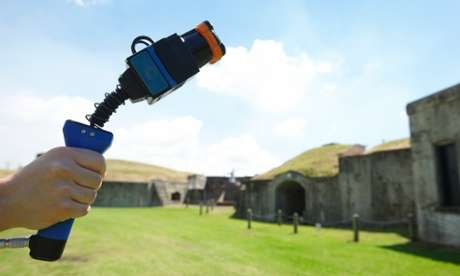The Zebedee scanner. Credit: CSIRO
(Phys.org) —Police in Queensland Australia have reported to the media that they now have and are using a device called the Zebedee scanner—it's hand held and can be used to laser scan a crime scene in just a matter of minutes for creation of a 3D image. The scanner was developed, police spokesmen Ian Stewart said, by Commonwealth Scientific and Industrial Research Organization (CSIRO)—Australia's premiere national science and research agency.
The Zebedee is based on technology that has been put to a variety of uses over the past several years –LIDAR—a remote sensing technology that works by sending out a laser beam and then reading what is bounced back. The hand-held Zebedee extends LIDARs capabilities (which are 2D) by affixing it to the top of a spring. By bouncing (and spinning) the laser around atop the spring, the beam strikes objects in every direction. A computer then connects all the 2D readings together to create a 3D image.
The police have been using the device to faithfully recreate an entire crime scene in as little as 20 minutes—adding another tool for investigators to use in solving crimes. The data captured can be looked at later by investigators or even people sitting in a jury box to get a better sense of what occurred at a crime scene.
The Zebedee is not the first such scanner—police in New Mexico have recently begun using a scanner they call the Faro 3D scanner system—it's based on the same basic technology, one that scientists have been using for other purposes for several years. Geologists use a similar scanner to map the insides of caves, and planet scientists have been using it to map the surface of the Earth from satellites. A similar device was also used recently to map the interior of the leaning tower of Pisa to gain a better understanding of its structure or to help in repair should it start to topple.
Stewart told the press that the Zebedee has thus far been most useful for crime scenes that are difficult to access (saving thousands of hours of manpower) that are having bad weather or at automobile accident scenes, which of course completely disappear once the cars are towed away. The next step, he said, is to put a Zebedee on a drone of some sort to allow for recreating scenes from above or from longer distances.
© 2014 Phys.org























